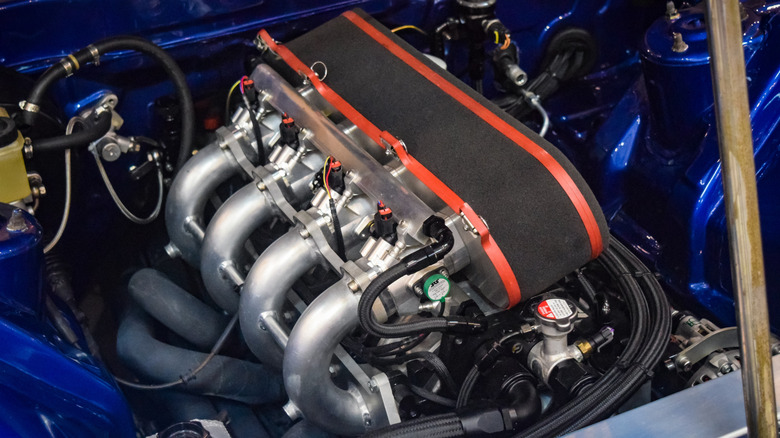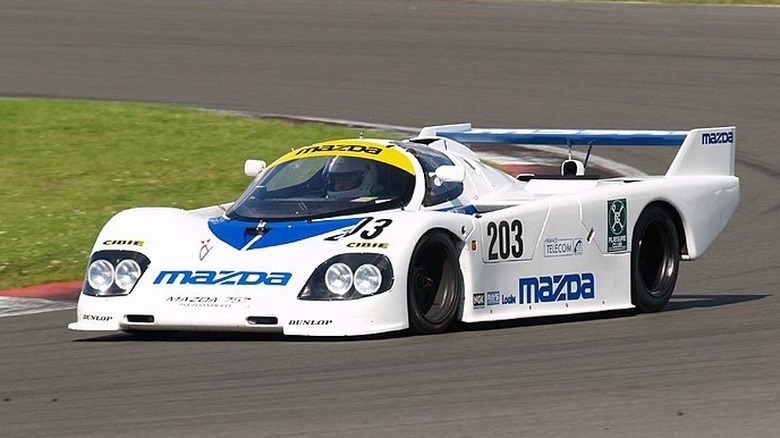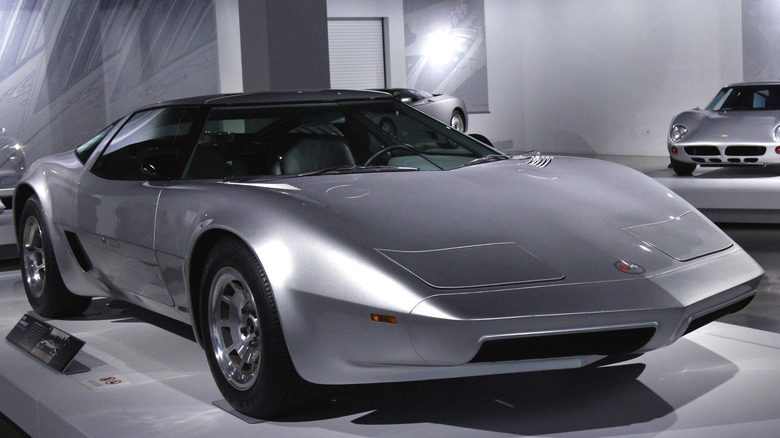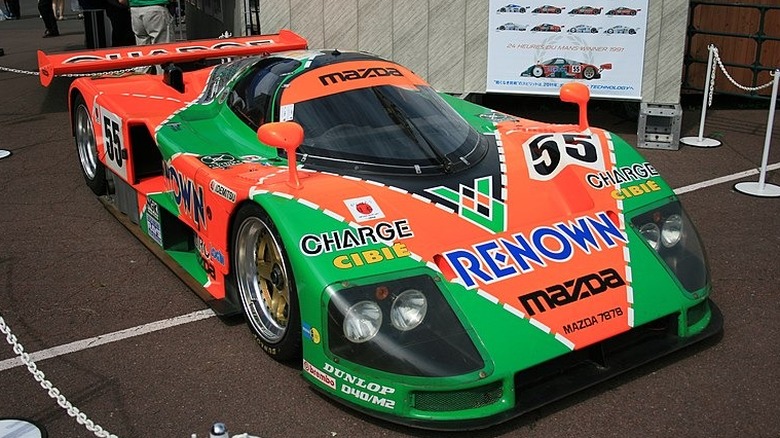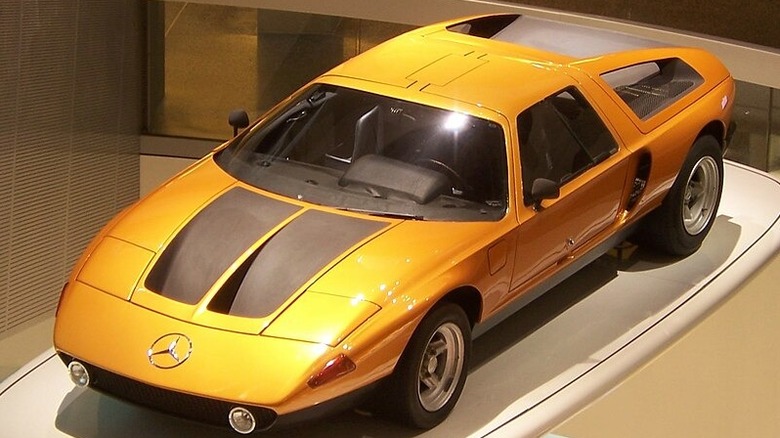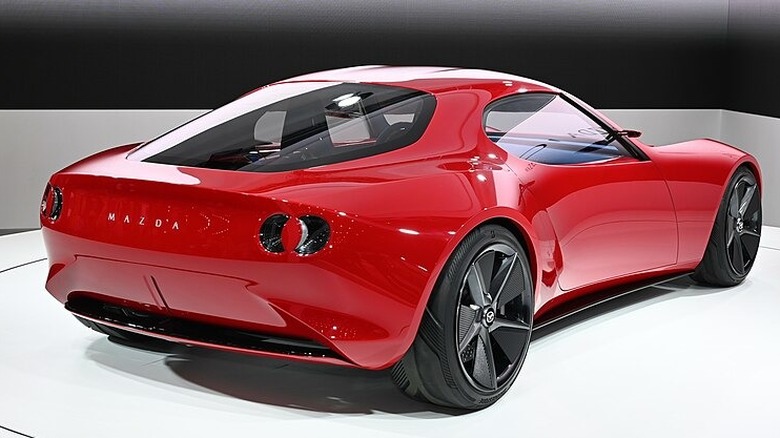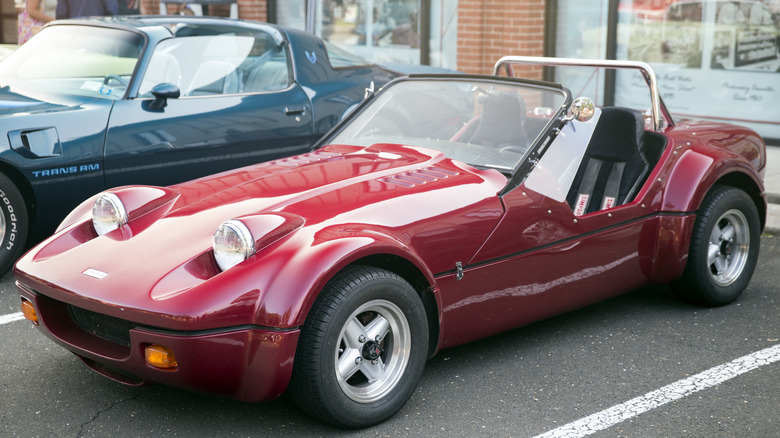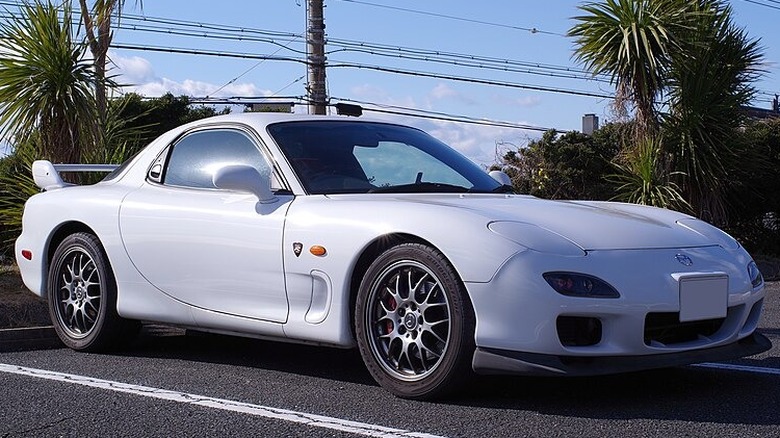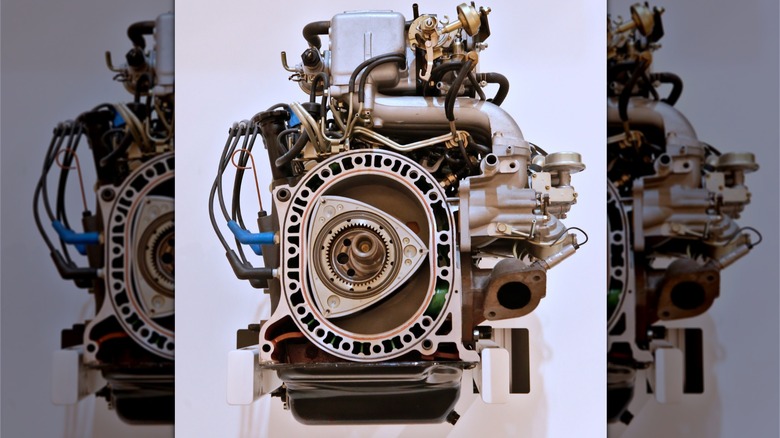7 Of The Most Powerful Rotary Engines Ever Put In A Car
The traditional piston engine has garnered the vast majority of attention and application in the internal combustion age, but there was another: the Wankel rotary engine. German engineer Felix Wankel designed the rotary engine in 1954. Employing a rounded triangular rotor spinning concentrically around a central shaft, Wankel rotary engines deliver glassy, smooth power and can produce impressive power ratings.
The rotary engine isn't perfect. Gas mileage isn't so great, finding someone willing to work on it can be a challenge, and they tend to burn oil and flood during cold starts. Still, their distinctive sound and quirky construction earned them fans and enthusiasts worldwide — and no, we're not just talking about Mazda.
Since the rotary engine's arrival, enthusiasts, tinkerers, and engineers have experimented to see how much power the unusual configuration can make, flaws or not. The results have been mixed. The rotary engine has graced engine compartments in everything from LeMans-winning race cars to build-it-yourself garage kits. Join us as we review seven of the most powerful rotary engines ever put in a car.
R26B 4-Rotor 1986 Mazda 757 521 hp
While we will look at rotary engines from a variety of manufacturers, in honor of Mazda's commitment to the rotary engine we kick off the list with one of the most powerful rotaries it ever produced. In the mid-1980s, Mazda was committed to achieving racing success with an all-Japanese-built rotary-engined car.
The 757 wasn't Mazda's first attempt at a rotary racer. Starting with the 717C in 1984, engineers employed a 1,300cc 13B rotary engine sourced from the RX-7. The modified 13B produced around 310 hp at 9,000 RPM and had underwhelming results on the track. In need of a fresh take, Mazda hired British designer Nigel Stroud. He developed an all-aluminum monocoque over a steel subframe with an upgraded Mazda 13G 1,962cc triple rotor Wankel engine nestled amidship. The resulting 1987 Mazda 757 made 444 horsepower, and the years of racing experience began to pay off.
As far from stock as a racer could get, the 1987 Mazda 757 participated in LeMans's Group C non-homologation prototype class. Two hours after the race started, one of the two 757s suffered engine failure and had to withdraw from the race. However, the other one finished in the top ten — albeit after a series of crashes and failures amongst competitors — with a seventh-place finish.
[Featured image by Darren via Wikimedia Commons | Cropped and scaled | CC BY 2.0]
XP-895 4-Rotor 1973 Chevrolet Aerovette 400 hp
When Mazda introduced the original rotary-powered production vehicle — the Cosmo Sport — in 1967, other producers got on the rotary bandwagon. General Motors (GM), Ford, Chrysler, Mercedes, and American Motors started up Wankel development teams. GM even paid a $50 million licensing fee for the rotary design. Corvette engineer Zora Arkus-Duntov was hot for a mid-engined 'Vette, but he was given the green light with a caveat — GM president Ed Cole demanded it be rotary-powered. The result was a pair of intriguing mid-engine Corvette prototypes that arrived decades before the 2020 C8 did it for real.
Arkus-Duntov acquiesced, instructing his engine expert, Gib Hufstader, to get on it. Hufstader paired two separate dual-rotor engines around a central shaft. The XP-895 debuted at the Paris Auto Show in 1973 alongside a single-engined dual-rotor-midship Corvette called the XP-987GT. The cars made a slash among fans and the press, sparking speculation that GM was heading for a mid-engined, rotary phase. The new approach was controversial among purists. Ultimately, the XP-895 went home to be refitted with a 400ci V8 piston engine.
In the end, Chevrolet reverted to form. Both cars are gorgeous, even today. Sweeping and classic, they carry the traces of past and future Corvettes, reminding us of the time we were this close to a mid-engined 'Vette in the 1970s.
[Featured image by Prayitno via Wikimedia Commons | Cropped and scaled | CC BY-SA 2.0]
R26B 4-Rotor 1991 Mazda 787b 681 hp
The seventh-place finish at Le Mans achieved by Mazda's 757 wasn't enough, and the Mazda team kept developing rotary racers. By 1991, Mazda had run out of time — the 60th running of the 24 Hours of Le Mans in 1992 would not allow rotary engines. Fortunately, Mazda engineers had devised a doozy of an engine for the 1991 season.
The 13G motor was history. In its place, the R26B was a four-rotor engine, each with three spark plugs, variable intake runners, mid-range torque, and a distinct wail at peak power. The engine accessed 95 percent of its maximum torque between 6,000 and 9,000 rpm. Keep the revs there, and the driver could scream around the circuit. With the class facing death, the Mazda 787B was Mazda's last hope. Weighing in at 1,850 pounds, it was ultra-lightweight, making the most of each of its 600 hp. Kismet seems to have stepped in on behalf of the hardworking Mazda team.
After an improbably flawless run around the Circuit de la Sarthe track at the 1991 24 Hours of Le Mans, the 787B chassis number 787B-002 completed 362 laps around the 13.6 km track, becoming not only the first (and last) rotary-engined car to win the legendary race, but the first Japanese team to take the checkered flag.
[Featured image by 韋駄天狗 via Wikimedia Commons | Cropped and scaled | CC BY-SA 3.0]
M950 3-Rotor 1969 Mercedes-Benz C111 350 hp
Mercedes also noticed the potential of Wankel power. The C111 arrived on the scene at the 1969 Frankfurt Auto Show. It was built as a testbed, a car upon which Mercedes could try out wacky ideas. Gull-winged and mid-engined, it wasn't anything Mercedes hadn't tried before, save for the M950 four-rotor Wankel behind the seats.
The C111 saw many iterations through the years. Mercedes put diesel, turbocharged, and rotary engines in the chassis and tested upcoming technologies like multi-link rear suspension and glass fiber reinforced plastic (GRP) body panels. However, the first C111 had an M950F containing a three-rotary setup. The original setup made 350 hp and 319 lb-ft of torque.
Mercedes continued to develop the C111. The C111 II had a four-rotor engine, the C111 III had a five-cylinder turbo-diesel, and the C111 IV had a plain old 493 hp V8 twin-turbo piston engine. Unfortunately, the 1973 gas crisis dampened enthusiasm for inefficient rotary engines, which suffer from poor fuel economy.
The Mercedes C111 may not have died with a rotary engine, but it was born with one, and, subjectively, it's a gorgeous car reminiscent of the De Tomaso Pantera or Ford GT40. If you're a Mercedes fan thinking about tracking down one of these C111s for yourself, forget about it. Only 17 prototypes were ever built (including all engine types). As of 2024, four of them have been destroyed, and the remaining 13 call the Mercedes-Benz Museum home.
[Featured image by Bergfalke2 via Wikimedia Commons | Cropped and scaled | CC BY-SA 3.0]
Hybrid 2-Rotor Mazda Iconic SP Concept 365 hp
The automobile world has changed entirely since Felix Wankel rotorized internal combustion, but the most impactful technological improvements are happening now. With the automobile world going EV, is there a new application for rotary engines?
That's the question Mazda asks with its Iconic SP concept, revealed ahead of the 2023 Tokyo auto show. Starting life as the Vision Study Model, some speculated it was Mazda's preview of an all-electric Miata. However, the futuristic fastback is something else entirely — a rotary-electric vehicle. The R-EV employs a dual-rotor engine to power an as-yet-unspecified motor layout, creating 365 hp. These are more than decent numbers – even in the age of the Hellcat – although if the Iconic SP, which is only slightly bigger than the Miata, weighs in at a portly 3,197 pounds.
Though some details remain murky, Mazda claims the rotary engine will charge the battery bank rather than the drive wheels. This is where it gets really interesting, as the engine can allegedly run on carbon-neutral fuel and "burn various fuels such as hydrogen," according to a statement provided by Mazda to Car and Driver.
It's hard to say for sure if the technology in the Iconic SP will make it to the street, but we sincerely hope so. Aside from being an exciting new small sports car from the company that makes the beloved MX-5, the car is gorgeous, not to mention it could also represent a paradigm shift in the utility of rotary engines.
[Featured image by Bergfalke2 via Wikimedia Commons | Cropped and scaled | CC0 1.0 ]
13B 2-Rotor Maxton Rollerskate 210 to 265 hp
If we told you to guess what 13B rotary-powered sports car whose two-syllable manufacturer's name starts with M and whose model names start with R, the Maxton Rollerskate would be the first thing to come to mind, right? Maybe not, but we're not talking about the RX-7 just yet.
Vintage car enthusiast and successful businessman Bob Sutherland loved classic roadsters like the Bugeye Sprite and the Lotus Seven. Not content to enjoy others' creations, he assembled a small team to build a kit roadster that would accommodate the 13B dual-rotor engine from a Mazda RX-7.
With a production run of just three years, only 50 Maxton Rollerskates ever came out of Sutherland's startup, but enthusiasts of the rotary roadster love to tinker. With a factory tune, the stock 13B would make about 210 hp –- respectable for a car that weighed a mere 1,680 pounds. It was a competent little SCCA racer and could run a 5.5 second zero to 62 mph. Still, that's not where the fun ends.
Enthusiast Ken Scheeper, who also owns a yellow RX-8 dubbed the Nuclear Banana that does a 7.27 second, 190 mph quarter-mile run, applied his rotary know-how to his own Maxton. The result is a 264 hp Rollerskate with a turbocharged Cosmo 13B under the hood.
[Featured image Mr.choppers via Wikimedia Commons | Cropped and scaled | CC BY-SA 3.0 ]
13B-REW Twin Turbo 2-Rotor Mazda RX-7 255 hp
We would be remiss not to include one of the most iconic JDM cars in history on our list. With 255 hp from a twin-turbo dual-rotor, the RX-7 doesn't raise many eyebrows for performance these days. However, it has long since cemented its legacy as the world's most popular rotary — unless Mazda really revolutionizes things with the Iconic SP.
Fast, furious, and fun, the RX series has inhabited pop culture and fans' driveways for decades. Though 255 hp seems paltry by modern standards, in the early '90s, it was nothing to shake a stick at. The RX-7 disappeared from the American market in 1995 — though it continued in Japan until 2002 — but it remains popular among enthusiasts, weekend warriors, and professional drivers. Third-generation RX-7s have seen values increase in recent years as they become more collectible.
The RX-7 was similar to the 757 and 787 race cars in that it was one of few products dedicated to rotary engine advancement. They wouldn't reach the astronomical power numbers of the bespoke racecars, but without Mazda pushing the rotary for decades, who knows where the technology would stand today? Either way, the sky is the limit on the max-power RX-7, with heavily modified builds that can make up to a thousand horsepower. A 13B-REW-powered '94 model splashed at SEMA in 2016 making 550 hp.
[Featured image by PENTAX K-1 via Wikimedia Commons | Cropped and scaled | CC0 1.0 ]
Honorable Mention: The world's only 12-rotor engine 1,400 to 5,000 hp
Though vastly outnumbered by traditional piston engines, the rotary has not yet heard its death knell. Aside from the Iconic SP's promise and hardcore fans' never-ending devotion, mechanics and tinkerers continue to fiddle with the engine configuration. While most rotary engines contain two, four, or even six rotors, one man has gone above and beyond to design the world's only 12-rotor engine.
Tyson Gavin wanted to see what kind of power he could make using the same space as a Chevrolet big-block. He deduced that a 12-rotor system would fit in the engine bay of a speedboat where a 454 might typically go. Composed of three sets of four rotors, the counter-rotating monstrosity displaces 15.7 liters inches and weighs 830 pounds. The engine has not found any real-world application, though Garvin claims a naturally aspirated version made 1,400 hp on the dyno. He theorizes that race fuel and methanol could create up to 5,000 hp.
